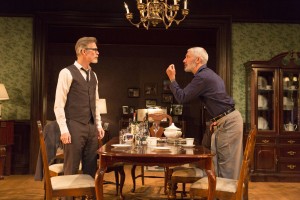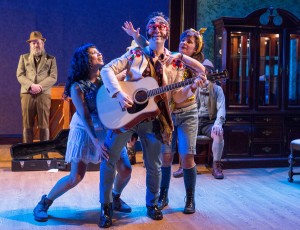 Last Tuesday, chatting with a friend about going to see The Winter’s Tale with my students, I let my professional demeanor slip and admitted that I think this play is “maybe the best of Shakespeare’s plays, not counting the ones that make you want to jump off a bridge.” Excluding the canonical joys of high nihilism, it’s hard to beat The Winter’s Tale‘s combination of paranoia, emotional intensity, music, festive comedy, and — eventually — artistic transcendence. I know as a Shakespeare prof I’m not supposed to have favorites but…
Last Tuesday, chatting with a friend about going to see The Winter’s Tale with my students, I let my professional demeanor slip and admitted that I think this play is “maybe the best of Shakespeare’s plays, not counting the ones that make you want to jump off a bridge.” Excluding the canonical joys of high nihilism, it’s hard to beat The Winter’s Tale‘s combination of paranoia, emotional intensity, music, festive comedy, and — eventually — artistic transcendence. I know as a Shakespeare prof I’m not supposed to have favorites but…
The Pearl Theater production on W. 42nd Street comes straight at you, with clarity and emotional intensity. If live theater is on some fundamental level a machine for concentrating emotions — and I think that’s a fair definition, though maybe not an exclusive one — what’s distinctive here is the directness of the production. In a small theater with a non-fussy modern set, the show dives directly in. Directed by Michael Sexton, Artistic Director of the Shakespeare Society, who directed a lively Titus at the PublicLab back in 2011, this production leveraged the play’s waywardness, its self-conscious resemblance to an “old tale,” for emotional power. Parts of it felt like opera, and not just during the music.
The strongest performance of the night was Jolly Abraham as Hermione, with a Bohemian turn as sexy country lass Dorcas in act 4. Her commanding presence was strong enough that for her final appearance as statue she didn’t ascend a pedestal, but instead stood still at center stage, drawing the audience’s eyes to her. While the audience gazed at the statue, the actors stared out over our heads, searching for what they couldn’t see. Once she started moving, they turned to see Hermione with wonder. Both both during and before her trial, the Queen ruled the stage while her husband cowered to one side.
Peter Francis James’s Leontes reminded me of the desperately child-like version of Lear that Derek Jacobi brought to Brooklyn in 2011. The king was needy as an infant, spewing his emotional desperation out into the theater. The force of that emotion made his jealousy explicable, because we all know that children can’t control themselves, but at the cost — as in the case of Jacobi’s Lear — of leeching away some of his monarchial majesty. The Sicilian king’s need to occupy the center wasn’t matched by his capacity to hold himself there.
At the break, one of my students confessed that she was really looking forward to getting to Bohemia. Since I’ve just written a Shakespeare Association of America conference paper that springboards off of the first couplet in Time’s speech — “terror” rhymes with “error” — I was also anticipating Time’s transitional speech in 4.1. The full cast returned to the stage with the house lights still on, some not all the way back into character — Polixenes was doing the Times crossword, and I think Leontes had a script in his hand. They started back in by playing an actors’ game: one nodded to the next and said “I” (Ay?), and then each in turn passed the hot-potato of attention around the stage. Hermione, not looking very dead, started the speaking with the couplet that (I would argue) focuses the play’s interest in transforming errancy into productive change —
I, that please some, try all, both joy and terror
Of good and bad, that makes and unfolds error…
The rest of Time’s thirty-two lines were parceled out among the full cast, a couplet or so at a time. Of the production’s scattered meta-theatrical gestures — a glance back at the audience before opening the dinner party in 1.1, the complex staging of the statue scene, Autolycus’s asides and soliloquies — this one seemed to me the strongest and most original, drawing the audience into the conspiracy and insisting on the need for everyone in the room to help re-order the fractured kingdoms.
I’m always a sucker for an Autolycus who channels Bob Dylan, and Steve Cuiffo, whose card tricks had entertained Mamillius in Sicilia, burst on the scene with guitar, guitar case, “pack,” and as many sheets as he could stuff into his pockets or drape over himself. He was great fun, though perhaps not sufficiently threatening to seem a true outlaw. His “Come buy” song during the sheep-shearing scene was less exploitation of the gulls whose purses he would later pick than simple celebration: no anxieties about capitalism or the money-print nexus in this production, though I think there are some in the play.
My long-ago student Alexis Soloski’s review in the New York Times thought the air went out of the balloon in Bohemia, or at least that the bitter winds of the West Side somehow snuck under the Pearl Theater’s door. It was hard to keep the energy up for the full three hours, but for me the only flagging came during the return to Sicilia, before the statue scene, when a final encounter between Autolycus and the Clown and Shepherd, newly “Gentlemen born,” did not yield many sparks. Perhaps if the thief had been more of a threat before, his final taming might have seemed more urgent?
The final moments on stage are everybody’s favorite image of theatrical magic, the last stop on a long road of show-stoppers. The text is somewhat ambiguous about the resumption of the marriage after sixteen years: “She hangs upon his neck” (5.3.112) says Camillo, played expertly by Tom Nelis, but when she speaks it’s only to her daughter. Three women take center stage and Leontes, as he had for much of his madness in the first half of the play, slinks over to one side. Hermione claims her daughter and her power:
Tell me, mine own ,
Where hast thou been preserved? Where lived? how found
Thy father’s court? For thou shalt hear that I,
Knowing by Paulina that the oracle
Gave hope thou wast in being, have preserved
Myself to see the issue. (5.3.123-28)
Leontes makes on last grab at the reins after this speech, marrying off Camillo and Paulina, insisting the Hermione and Polixenes look on each other, asking that Paulina lead everyone offstage. But I’m not sure — in this production, at least, it seemed pretty clear that Hermione hadn’t come back for him.
UPDATE: Bear thinking…
Since tweets once tweeted are lost forever (I think), I’m going to add some “Pursued by a Bear” thoughts that emerged from a twitter chat with @BoydaJosa. The famous bear of 3.3 was performed by the whose cast except Antigonus, who plays the part of the bear’s dinner. I enjoyed the collectivist implication of a six-person bear-train in fur coats: as with Time, the cast performs the key transitional parts as a group. I also thought it was an interesting choice to have Hermione carrying the bear’s head and open jaws. She remained powerful even when supposedly dead; she also also came on stage to speak the lines her “ghost” says to Antigonus during his relation of the dream of shipwreck. My students and I also talked about the great visual moment in which the bear-collective surrounded Antigonus, tearing him to shreds and pulling out his intestines in long white sheets, which would become the sheets that transformed the set from arid Sicilia to festive Bohemia. The price of spring’s arrival? It also made a striking contrast to the several funny bears I’ve seen, including Propeller’s use of Mamilius’s teddy bear in the part.


Leave a Reply